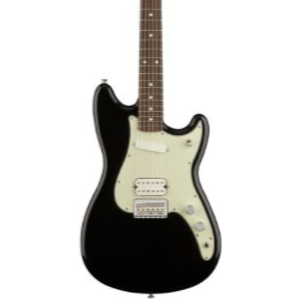- Home
- Instruments
- Gear
- Recording
- Lessons
- Reviews
- Blog
Though the Duo-Sonic HS may be a relatively new addition to Fender's product catalogue, its roots go all the way back to the company's early history. In fact, this new Duo-Sonic model is inspired by a vintage axe Fender offered in the 1960s.
While the first incarnation of the Duo-Sonic was designed as a practice axe for new and improving players, this recent model offers some higher-end touches that make this an excellent instrument even for more advanced guitarists.
It all adds up to a fresh, unique package that's sure to turn heads with its style and sound. Let's take a closer look and break down what makes the Duo-Sonic HS one of the best guitars available under $500.
 Body and Neck
Body and NeckIf you're familiar with Fender's classic Mustang model, you'll immediately recognize the Duo-Sonic's body shape. The new model borrows much of its double-cutaway styling from the Mustang's blend of offset shape and Stratocaster curves. As with the vast majority of Fender's lineup, the Duo-Sonic's body is constructed out of alder.
A 22-fret Pau Ferro fingerboard sits atop the maple neck. The 24″ scale length is a bit shorter than Fender's traditional 25.5″ scale — the shorter space makes fretting big chords easier and provides a slinkier feel for bending and single-note work. The slightly smaller nut width (1.65″) keeps things manageable for players with smaller hands without making the neck cramped.
Likewise, the 9.5″ fingerboard radius offers a good blend between more curved styles (easy for chords) and a flatter neck (better for bends and single notes). The neck, a modern “C” shape model, is also finished in a satin gloss, unlike the rest of the body. The small change makes a big difference for slides and vertical runs along the fretboard.

For an affordable model, the Duo-Sonic HS offers a broad palette of tones. The neck pickup is a classic Fender single-coil, delivering smooth, balanced sound with plenty of Fender's famous top-end sparkle. The bridge pickup, meanwhile, is a vintage humbucker model. That creates a thicker, heavier sound and is awesome for playing songs with heavier distortion.
The other controls are pretty straightforward: a three-way switch allows you to toggle between the pickups, while two knobs serve as master volume and tone controls. One unique feature here is the coil-splitting for the bridge pickup: if you'd prefer a single-coil sound, you can simply push or pull on the tone knob to turn the humbucker into a single-coil pickup.
On the mechanical side of things, the Duo-Sonic HS features a standard complement of Fender accessories. Medium-jumbo frets facilitate faster, smoother playing, while a synthetic bone nut and Fender cast tuners keep your tuning stable.
One interesting choice is the Stratocaster-style hardtail bridge. The bent steel saddles in this unit allow you to adjust the intonation and action of each string individually — something that's simply not possible on the Mustang. And while there's no vibrato unit equipped here, the bridge still features a string-through design like a traditional Stratocaster. If nothing else, it sure does look cool!
Few guitars in this price range that can deliver both the range and the quality of tones that the Duo-Sonic HS does. Whether you're on the neck pickup, bridge humbucker, or mixing them together, it's hard to find a bad sound on this instrument.
The neck pickup is refined without being tame. With the tone knob rolled off, it's warm and smooth. Bring the presence back up, and it shimmers with a bright, clear treble range. It's great for rock, funk, and a plethora of other genres — even when dialed down, it cuts through a mix well, making it a great option to use in jam sessions or on live gigs.
The bridge humbucker, meanwhile, offers more body and midrange meat than the neck single-coil. The tonal response is immediate and dynamic; it shifts from focused and sharp with the knob all the way up to muffled and dark with it rolled fully off. Whether you're using the bridge pickup alone or blending it together with the neck, the best tones lie somewhere in the middle.
The bridge also handles distortion exceptionally well — the humbucker delivers a fat, throaty saturation that many players prize.
The Fender Duo-Sonic HS seems to straddle two different worlds. While it's not out of reach for beginner players, its tones and versatility suggest a more expensive model. It might not be as iconic as a Telecaster or as ubiquitous as a Strat, but this humble model delivers an ear-catching sound that nearly any player will love.

Reader Interactions